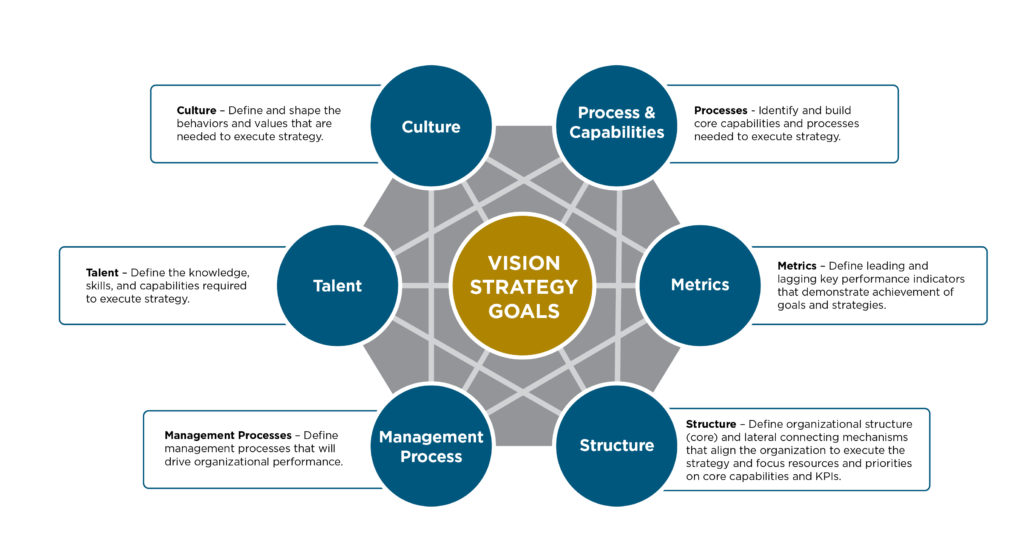
By: Jeff Chan
Have you heard the saying, “every organization is perfectly designed to get the results it gets?” Unfortunately, the design is usually not the product of an intentional and deliberate process. Instead, organizations tend to evolve through a series of independent changes in structure, operations, people, and management practices. These changes result from specific challenges, or through the adoption of various processes in different departments. For this reason, it’s not surprising that some businesses may struggle to perform at a high level.
Organizational design is not just structure, it consists of multiple elements shown in the graphic below. Each of these elements need to be designed and aligned properly to implement strategy and achieve the desired results.

The Six Elements of Success
Below are six elements of organizational design that are needed to execute strategy and tips to help avoid dysfunction and poor performance.
1. Process and Technology
Which processes are critical to execute your strategy? How well are these processes performing? If your organization is struggling to achieve its goals, this is a good place to understanding why.
2. Talent
Do your people have the skills needed to execute the processes critical to your strategy? Are your leaders aligned on how best to execute the strategy?
3. Structure
Does the organizational structure focus on the people, priorities, and areas most needed to execute the strategy? How well do people work across organizational silos to meet customer needs?
4. Metrics and Goals
How aligned are your metrics and goals with your priorities and strategy? Do you have key indicators in place that help you adjust to reach your goals?
5. Culture
What behaviors, mindsets, and values are needed in your organization to execute your strategy? How aligned is your current culture to the culture that is needed to execute your strategy?
6. Leadership Practices
Do your leaders have the capabilities and characteristics to motivate teams and support the strategy?
When to Adjust Your Organization Design
Organizational design is key to executing your strategy, and you should review it regularly to ensure the six elements are aligned and effective. Think of this review like an annual checkup with your doctor. You should analyze your organization’s key elements and assess how they fit into the overall strategy. In some cases, no action is required, but this practice will help ensure the organization remains in good health.
Here are three common situations that should trigger an organizational design review.
1. New Strategy
If your organization has developed a new business strategy, maybe in response to changing customer or market needs, a full organizational design review can help ensure you’re structured to successfully implement the new strategy.
2. Performance Issues
The performance of the organization is not where it needs to be. Maybe your team is struggling with:
- Serving customers
- Reaching organizational goals
- Quality and service issues
The root cause of these performance issues is a misalignment of one of the organizational elements – processes, talent, metrics, or structure.
3. Change in Structure, Systems, or Regulations
Acquisitions, mergers, divestitures, or the implementation of new technologies should kick-start a full review of your organizational design.
When you are faced with any of these situations, it is important to properly identify which of the key elements require change. This will ensure that you are not making any unnecessary changes and that the situation is resolved across the entire organization.
Organizational design is a skill you can learn to align people, processes, and technology to meet ongoing business realities. When it is done well, it ensures sustained performance and yields positive results.
To get started, download the Organization Design Assessment. This assessment will help you understand how your organizational structure may be impacting your goals.
About the Instructor: Jeff Chan

Jeff specializes in working with companies to improve organizational performance and productivity through expertise in change management and business transformation. He has held general management and senior human resource positions with BP/Amoco, Hewitt, Sears, Spiegel, and for the past 10 years has been the President of Chan Management Consulting.